Almost from the day it was invented, the torpedo was seen as the counter to the battleship. Suddenly, the smallest craft could carry and use a weapon capable of sinking a battleship, a task that had previously required another vessel of the same type. But despite this apparent dichotomy, many battleships did carry torpedoes, and it's worth taking a look at these weapons.
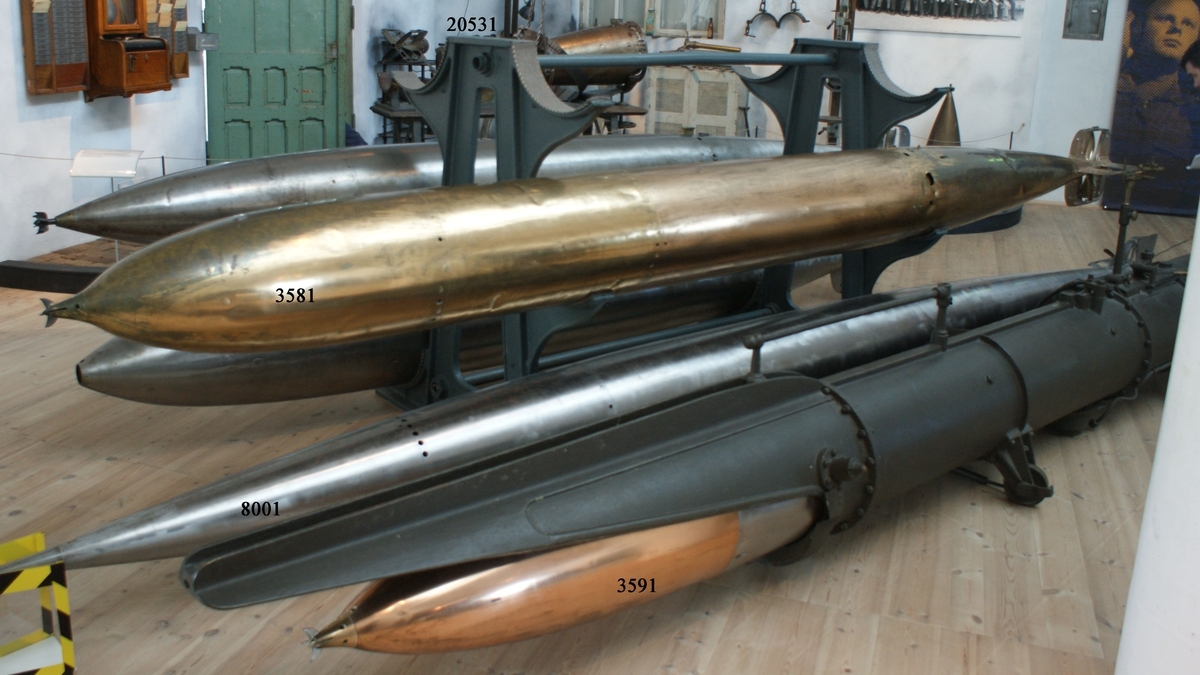
Early Whitehead torpedoes
The British first began to fit their ironclads with torpedoes in 1879, when HMS Devastation was fitted with a torpedo-launching carriage on each side, firing through a port cut in the breastwork armor. At the time, torpedoes were only capable of ranges of a few hundred yards, and speeds of maybe 20 kts, but this wasn't a huge problem. Many officers still thought that the ram would be a major weapon, which meant that their ships would be very close to those of the enemy. The torpedo was seen as an adjunct to the ram, capable of extending its reach to the sides or compensating for a miss. How well the launching gear would have worked in combat is dubious at best. At the time, launching a torpedo from above the water was a tricky business, and the carriages were unlikely to work well at high speeds. To make matters worse, in some cases they were on the exposed decks, which would have made them exciting to use in combat.
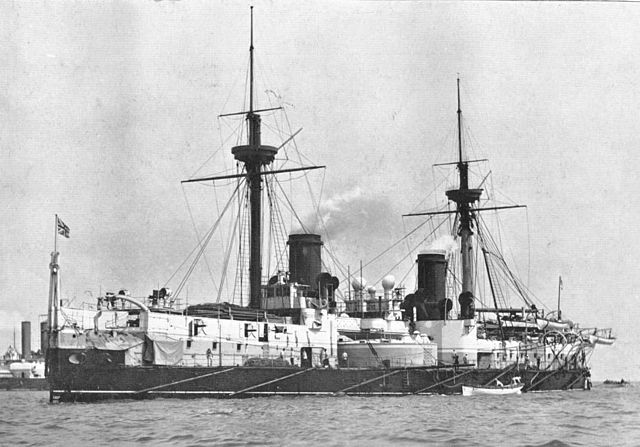
HMS Inflexible
Details on the first battleship torpedoes are surprisingly sparse, and the first ship I have much information on is HMS Inflexible. She had four torpedo launchers, two in chutes at the bow and stern and two underwater torpedo tubes, the first aboard a British battleship. These were cast-iron cylinders, one on each beam, attached to the hull via ball-and-socket joints to allow them to be aimed at the target on orders from topside. Each 14" torpedo was loaded into a brass cylinder that was rammed into the torpedo tube, and the tube was then sealed and flooded. A guide beam was extended from the tube to keep the torpedo from being deflected or damaged by the flow of water past Inflexible's hull, and a piston forced the torpedo out and activated its motor. Five years later, HMS Colossus used a similar system, but with the torpedo tubes mounted above water, behind the main belt. These tubes could train 30° fore or aft of the beam, and they were hinged so that they could be folded against the hull when not in use, probably because the space was also used to hang hammocks.1
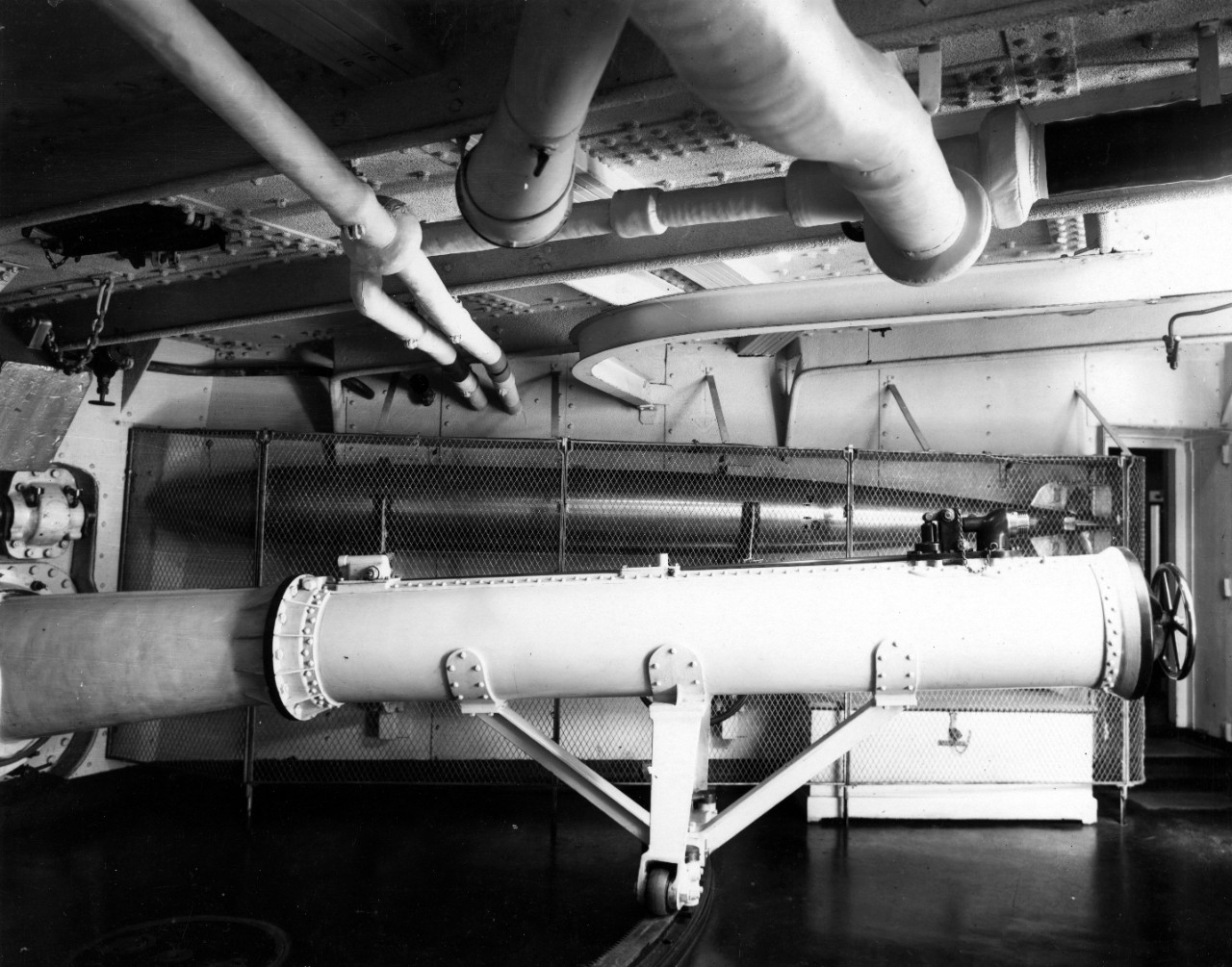
Torpedo tube aboard USS Illinois (BB-7)
From then on, most battleships were equipped with some form of torpedo tube, although the exact details varied greatly. HMS Victoria had eight tubes, one above-water tube in both the bow and stern, and two above-water and one submerged tube on each beam. This was duplicated in the Royal Sovereigns, the first of the pre-dreadnoughts, with the exception of the bow tube, which was deleted. The above-water beam tubes were abandoned with the follow-on Majestic class, as the danger of a shell hitting one and setting off the torpedo's warhead was judged too great. Initially, torpedoes had carried only small warheads, so the risk had been considered acceptable, but as they grew, so did the risk of serious structural damage from a hit. This danger was graphically illustrated at Santiago in 1898,2 and by 1900, underwater tubes were universal. The typical pre-dreadnought had four tubes, two on each beam, and about 18 torpedoes, which were usually winched into the tube using an overhead rail.
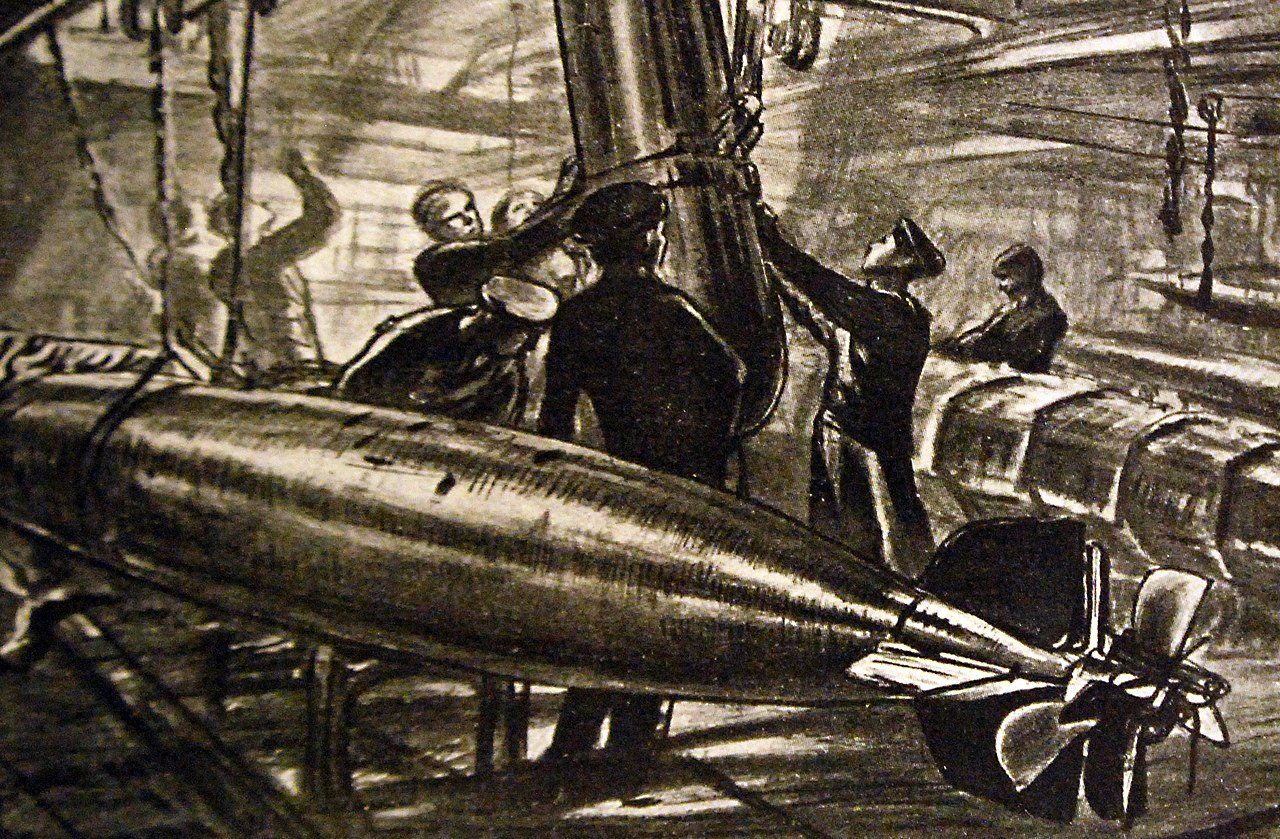
A drawing of a torpedo flat on a British dreadnought. The torpedo at left is partway into its tube, while the men are striking down another torpedo in the center.3
The invention of the heater4 around 1900 increased the range of torpedoes to around 4,000 yards, changing them from a close-quarters weapon into one capable of threatening a battleship at the ranges it was expected to fight. This in turn drove improvements in fire control to allow ships to fight at longer range, and ultimately lead to the creation of Dreadnought. This didn't reduce the incentive for battleships to carry torpedoes, with Dreadnought herself having two torpedo rooms, fore and aft, both housing a pair of tubes, one on each beam. To reduce the space required for the torpedo room, the torpedoes were no longer inserted through the rear of the tube. Instead, there was a hinged side door which allowed a much longer torpedo to be loaded in a given space.5 There were two advantages to this. First, the torpedo rooms could be pushed out towards the ends, away from the space-hungry engineering plant and magazines.6 Second, the torpedo room7 was often one of the larger underwater spaces on a ship outside of the engines. This made flooding a serious concern, particularly as it had to be near the skin of the ship to fire the torpedoes, reducing the effectiveness of the ship's underwater protection. By this point, tubes were fixed to the ship's side instead of being aimable, and it wasn't until the introduction of gyro angling around 1910 that the torpedo could be set to a specific course rather than just heading out from the side of the ship. This ultimately lead to the stern tube being discarded from British battleships, as the broadside tubes could now cover much wider arcs.
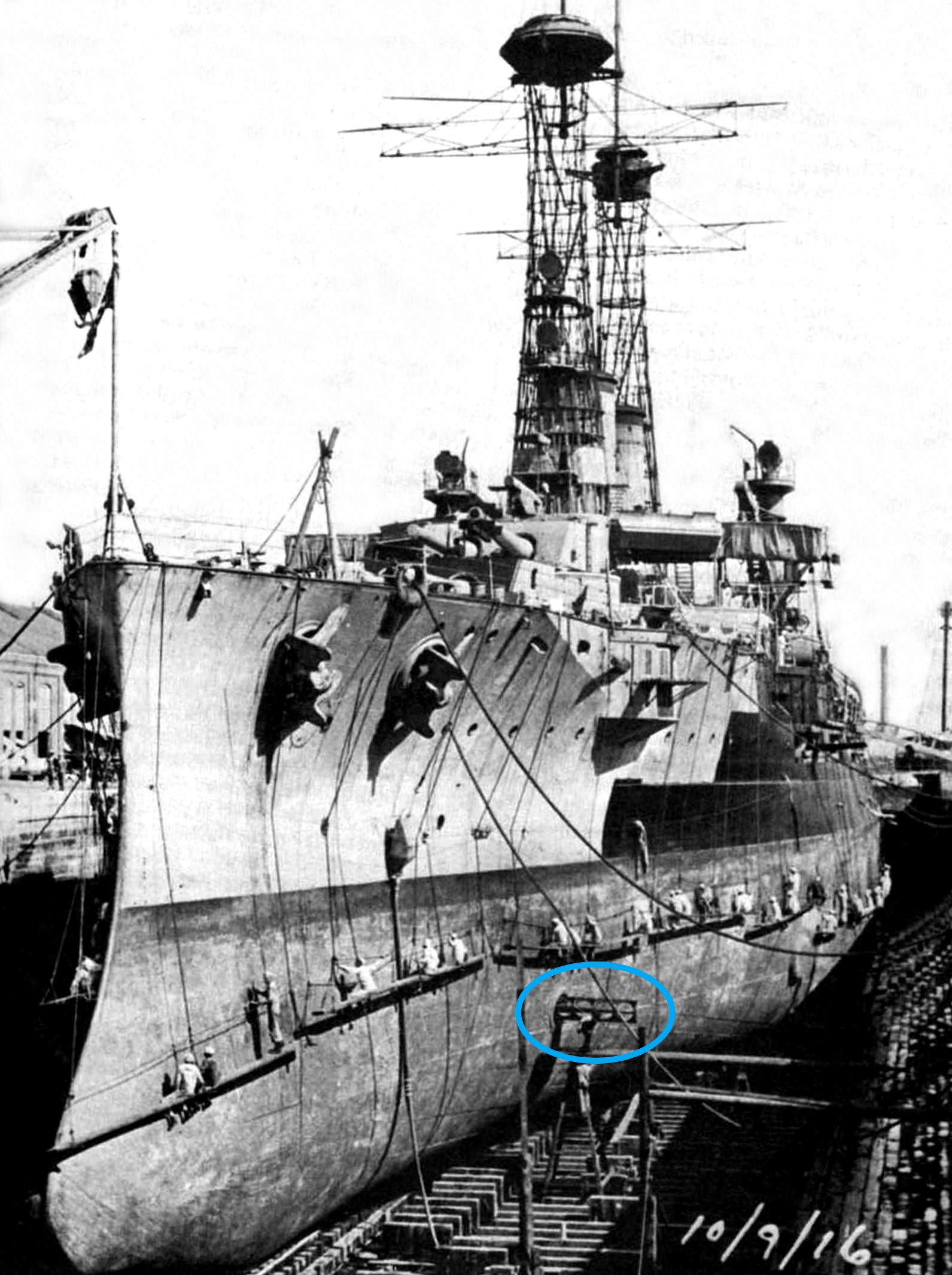
USS Florida in drydock with her torpedo bar extended, circled in blue
Most other navies followed a similar pattern to the British, with either two or four underwater broadside tubes on their battleships. Germany was unusual in keeping a bow tube on its battleships, for reasons I'm not entirely sure of. The Americans fitted most of their ships with two tubes, the only exceptions being the New York class. Despite this, they had a lively respect for the torpedo, and designers were often asked for 6 or more tubes. The Nevada and Pennsylvania classes were actually laid down with a second torpedo room aft of the armored belt, but while the hulls were built with the appropriate openings, the tubes were apparently never operational. The reasons for this are unclear, as is what was done with the spaces instead. The Japanese, in a sign of things to come, fitted more torpedoes than anyone else. The Fuso and Ise classes had six underwater broadside tubes, while the Kongo class battlecruisers had eight. The Nagatos also had eight, four submerged and four above-water. The completed French dreadnoughts had two underwater tubes on each broadside, while the abortive Normandie class had three spread across two torpedo rooms, with two to starboard and one to port forward, and the proportions reversed aft.
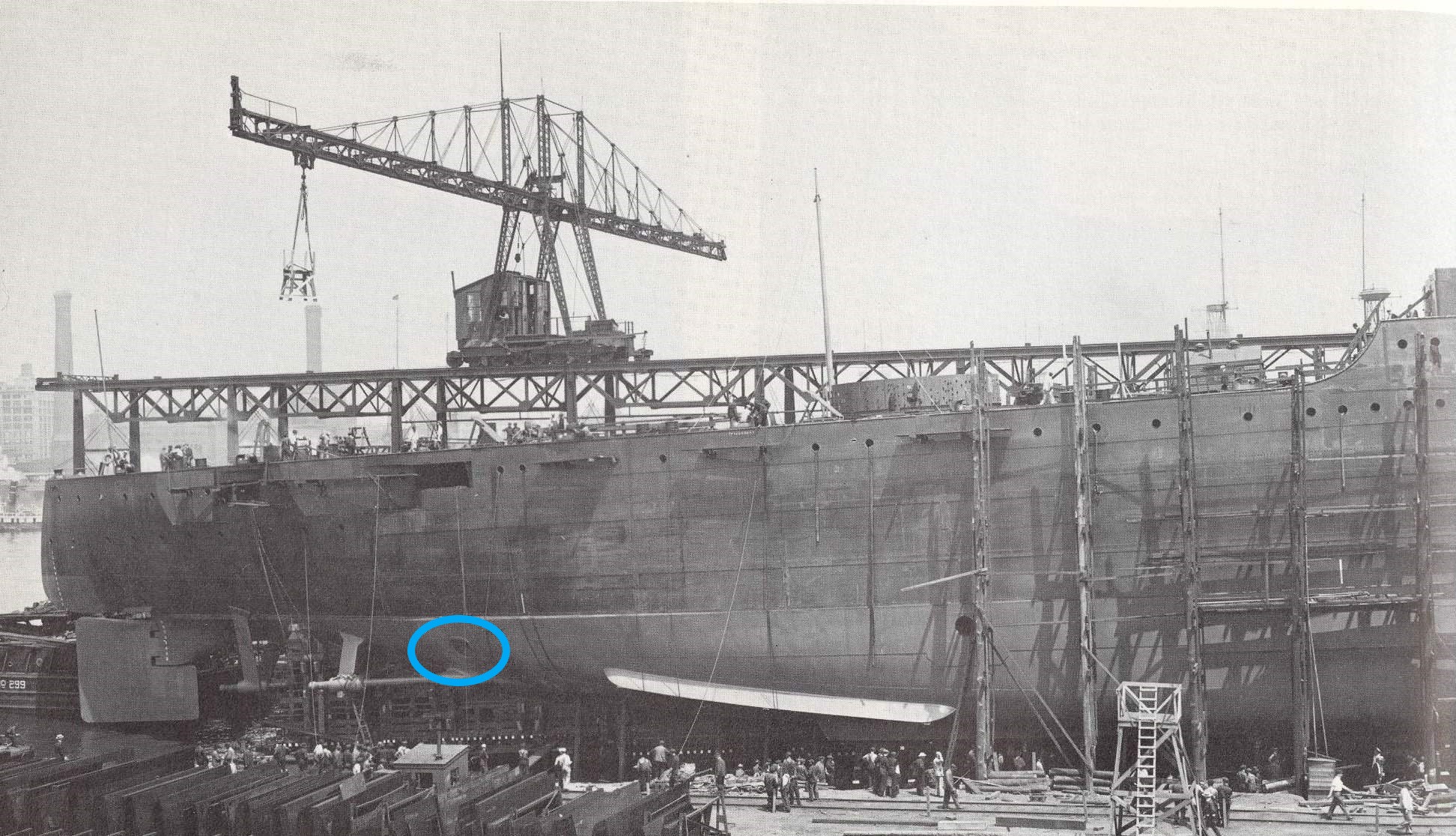
Arizona just before launch, showing the opening for the aft tube, which was never fitted operationally.
The rationale behind these tubes, at least in British service, was simple.8 While a torpedo was unlikely to hit a given target at long range, a line of battleships would have 400' long ships spaced about 400 yards bow-to-bow. Mathematically, torpedoes fired at it would have a 1 in 3 chance of hitting, and the limitations of contemporary fire-control systems meant that dodging to avoid such "Browning Shots"9 would reduce accuracy. By 1910, heaters had been improved by the use of water injection to drive ranges as high as 10,000 yards, again approaching expected battle ranges. As a result, while Dreadnought's immediate successors dropped to only a pair of broadside tubes and a stern tube, by 1910 the Admiralty wanted at least 4 broadside tubes.10 However, this would have meant significant increases in length and weight, 5' and 250 tons for the King George Vs while Queen Mary would have gained 10' and 400 tons. Ultimately, this was not accepted for the 1910 ships, but it was implemented on all later prewar British battleships.
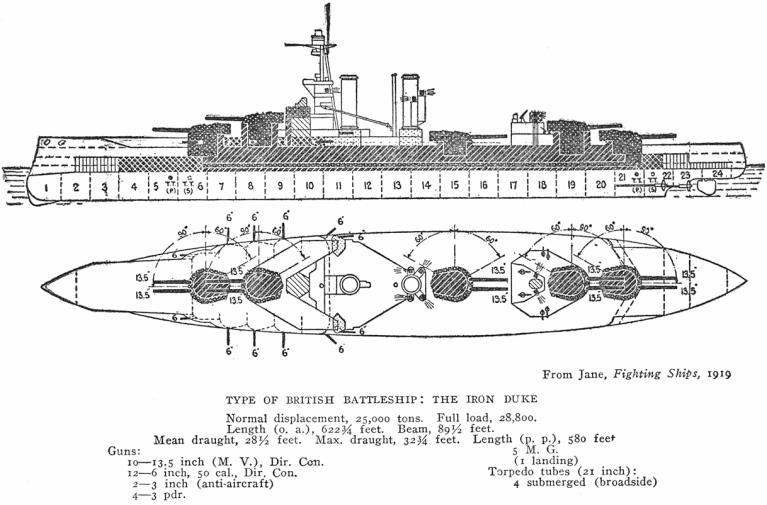
The Iron Duke class, showing the location of the torpedo tubes
The British were essentially alone in planning to use their battleships' torpedoes during a battle-line engagement, although their tactics were based around the assumption that the Germans were planning to do the same.11 For instance, Jellicoe's turn away at Jutland can be seen as avoiding an imminent browning-shot attack on the Grand Fleet. They put a great deal of work into making their torpedoes even more lethal, most notably designing and testing several different mechanisms designed to make their torpedoes run in a circle or rectangle at a specific range, giving each weapon several chances to hit the enemy fleet. These early pattern-running torpedoes preceded the German adoption of similar technology by about 30 years, but WWI broke out before they could be deployed and none seem to have seen service.
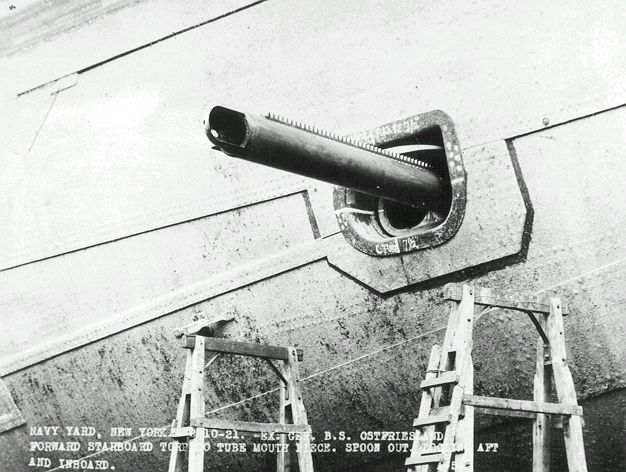
A torpedo tube and bar aboard Ostfriesland while she was in USN hands
The outbreak of the First World War would give the torpedo its first real test as a weapon, and while the submarine used it to deadly effect and the destroyer also gave it a workout, the battleship rarely got a chance to use underwater weapons. We'll look at the one case where it did next time.
1 Until after WWII, most RN sailors slept in hammocks, and the era in which they were hung on the gun deck wasn't so far in the past when Colossus commissioned. ⇑
2 This led the US to deactivate all above-water tubes immediately, although 5 years later, the Naval War College's games had shown the importance of torpedoes to the battle fleet. ⇑
3 I apologize that this is the best representation of the British battleship torpedo I was able to find, but my usual sources were completely unhelpful. ⇑
4 The first torpedoes ran entirely on compressed air, while heaters burned some sort of fuel, greatly increasing energy density and thus range (or speed). ⇑
5 Another aspect of this was probably the increasing length of torpedoes during this time, as a longer torpedo had more volume for compressed air flasks, allowing even longer range. ⇑
6 This also avoided the need to cut holes in the belt, as the torpedo spaces had been pushed outside the citadel. ⇑
7 Sometimes known as the torpedo flat. ⇑
8 I don't have nearly as good a grasp on the logic behind the torpedoes in other navies. The lack of coherent doctrine to explain features of ships is surprisingly common before WWII. ⇑
9 So called after firing "into the brown", shooting at a group of enemy soldiers on land as a unit instead of picking an individual target. ⇑
10 The early ships had 18" tubes, but they were replaced by 21" tubes starting with the Colossus class. There was talk of trying to retrofit the earlier classes with 21" tubes, but it never took place. ⇑
11 The Japanese torpedo doctrine that proved so effective in the Solomons was probably based on British thought around 1918. ⇑

Comments
I sort of expected that just as battleships lost their secondary batteries to cruisers, torpedo attacks would have been left to destroyers. Presumably since underwater tubes don't compete for topside space or fire control in the same way there was less pressure to remove them?
I know of some proposals for battleships without secondary armament, but I don't believe any were ever built that way. As for torpedoes, they did go away in most navies pretty quickly after WWI.
By 'secondary battery' I'm referring to the 6" and 8" guns that might be found on pre-dreadnoughts (and cruisers), but generally not on all-big-gun designs. I suppose the diagram of Iron Duke above should have been enough to show me that 6" guns at least quickly found there way back aboard.
Those weren't really secondary guns. They were essentially part of the primary armament, intended to be used against other battleships. There were other guns for fending off torpedo boats. Dreadnought had 12 pdr/3" guns, and most of the early successors before the Iron Dukes had 4" guns for use against torpedo boats.
So what was the "Japanese torpedo doctrine that proved so effective in the Solomons"?
I assume that's coming in part 2?
Fascinating stuff. None of the books I read as a kid did more than mention battleship torpedoes existing, with nothing at all about their intended use.
@Doctorpat
I was referring to the Japanese use of torpedoes at battles like Savo Island and Tassafaronga. I don't cover that in Part 2, as the torpedoes weren't coming from battleships.
@Echo
Yeah, this series was me going "Hey, I don't know much about this, let's find out everything I can."
Thanks for writing this! I did stumble over one minor typo: "USS Flordia".
(Feel free to delete this comment, obviously.)
Thanks. Fixed.